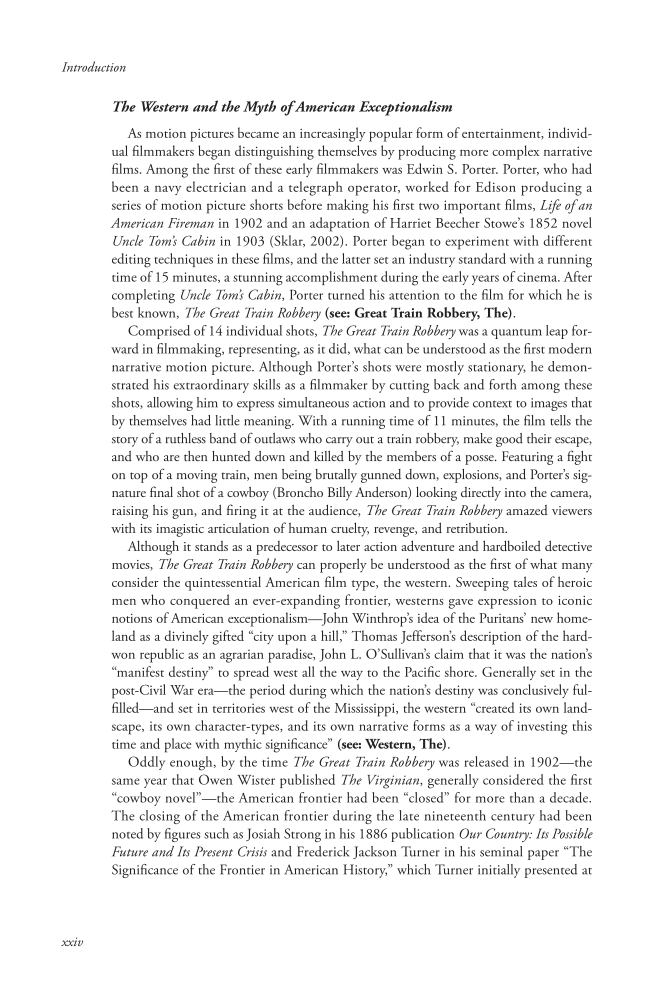The Western and the Myth of American Exceptionalism As motion pictures became an increasingly popular form of entertainment, individ- ual filmmakers began distinguishing themselves by producing more complex narrative films. Among the first of these early filmmakers was Edwin S. Porter. Porter, who had been a navy electrician and a telegraph operator, worked for Edison producing a series of motion picture shorts before making his first two important films, Life of an American Fireman in 1902 and an adaptation of Harriet Beecher Stowe’s 1852 novel Uncle Tom’s Cabin in 1903 (Sklar, 2002). Porter began to experiment with different editing techniques in these films, and the latter set an industry standard with a running time of 15 minutes, a stunning accomplishment during the early years of cinema. After completing Uncle Tom’s Cabin, Porter turned his attention to the film for which he is best known, The Great Train Robbery (see: Great Train Robbery, The). Comprised of 14 individual shots, The Great Train Robbery was a quantum leap for- ward in filmmaking, representing, as it did, what can be understood as the first modern narrative motion picture. Although Porter’s shots were mostly stationary, he demon- strated his extraordinary skills as a filmmaker by cutting back and forth among these shots, allowing him to express simultaneous action and to provide context to images that by themselves had little meaning. With a running time of 11 minutes, the film tells the story of a ruthless band of outlaws who carry out a train robbery, make good their escape, and who are then hunted down and killed by the members of a posse. Featuring a fight on top of a moving train, men being brutally gunned down, explosions, and Porter’s sig- nature final shot of a cowboy (Broncho Billy Anderson) looking directly into the camera, raising his gun, and firing it at the audience, The Great Train Robbery amazed viewers with its imagistic articulation of human cruelty, revenge, and retribution. Although it stands as a predecessor to later action adventure and hardboiled detective movies, The Great Train Robbery can properly be understood as the first of what many consider the quintessential American film type, the western. Sweeping tales of heroic men who conquered an ever-expanding frontier, westerns gave expression to iconic notions of American exceptionalism—John Winthrop’s idea of the Puritans’ new home- land as a divinely gifted “city upon a hill,” Thomas Jefferson’s description of the hard- won republic as an agrarian paradise, John L. O’Sullivan’s claim that it was the nation’s “manifest destiny” to spread west all the way to the Pacific shore. Generally set in the post-Civil War era—the period during which the nation’s destiny was conclusively ful- filled—and set in territories west of the Mississippi, the western “created its own land- scape, its own character-types, and its own narrative forms as a way of investing this time and place with mythic significance” (see: Western, The). Oddly enough, by the time The Great Train Robbery was released in 1902—the same year that Owen Wister published The Virginian, generally considered the first “cowboy novel”—the American frontier had been “closed” for more than a decade. The closing of the American frontier during the late nineteenth century had been noted by figures such as Josiah Strong in his 1886 publication Our Country: Its Possible Future and Its Present Crisis and Frederick Jackson Turner in his seminal paper “The Significance of the Frontier in American History,” which Turner initially presented at Introduction xxiv
Document Details My Account Print multiple pages
Print
You have printed 0 times in the last 24 hours.
Your print count will reset on at .
You may print 0 more time(s) before then.
You may print a maximum of 0 pages at a time.

































































































































































































































































































































































































































































































































































































































































































































































































































































































































































































































































































































































































































































































































































































































































































































































